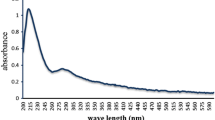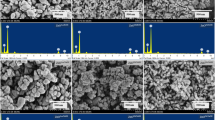Abstract
This research aims to investigate the influence of soluble starch; lactose; carboxymethyl cellulose; urea; and polyvinylpyrrolidone on synthesis of zinc oxide nanoparticles (ZnO-NPs). Zinc acetate was used as a precursor under alkaline conditions to produce ZnO-NPs as a low-cost and efficient antimicrobial and UV-blocking agent. Characterization and antimicrobial functional properties of prepared nanoparticles were investigated and reported using FTIR, TGA, XRD, TEM, analysis, as well as antimicrobial assay, respectively. The results revealed that the thermal decomposition profile, size of ZnO-NPs, IR spectra, as well as antimicrobial activity of the prepared ZnO-NPs is governed by the type of capping agents. Crystallinity analysis showed identical patterns in peak intensities and width irrespective of the used capping agents. On the other hand, the obtained results disclosed that using soluble starch as a capping agent results in attaining lower particle size of 3–5 nm and higher antimicrobial efficacy as compared with the other capping agents.








Similar content being viewed by others
References
Abdel-aziz MS, Eid BM, Ibrahim NA (2014) Biosynthesized silver nanoparticles for antibacterial treatment of cellulosic fabrics using O2-plasma. AATCC J Res 1:6–12
Becheri A, Dürr M, Lo Nostro P, Baglioni P (2007) Synthesis and characterization of zinc oxide nanoparticles: application to textiles as UV-absorbers. J Nanoparticle Res 10:679–689
Bershtein EM, Vasilyeva NG, Polyak MS (1983) Unification of nutrient medium for determination of biological activity of some antibiotics with agar diffusion method. Antibiotiki 28:250–254
Guo L, Yang S, Yang C, Yu P, Wang J, Ge W, Wong GKL (2000a) Highly monodisperse polymer-capped ZnO nanoparticles: preparation and optical properties. Appl Phys Lett 76:2901
Guo L, Yang S, Yang C, Yu P, Wang J, Ge W, Wong GKL (2000b) Synthesis and characterization of poly (vinylpyrrolidone)-modified zinc oxide nanoparticles. Chem Mater 12:2268–2274
Hassabo AG, Nada A, Ibrahim HM, Abou-Zeid NY (2015) Impregnation of silver nanoparticles into polysaccharide substrates and their properties. Carbohydr Polym 122:343–350
Hingorani S, Pillai V, Kumar P, Multani MS, Shah DO (1993) Microemulsion mediated synthesis of zinc-oxide nanoparticles for varistor studies. Mater Res Bull 28:1303–1310
Ibrahim N, Gouda M (2009) UV-protecting and antibacterial finishing of cotton knits. J Appl Polym Sci 112:3589–3596
Ibrahim NA, Eid BM, Youssef MA, Ibrahim HM, Ameen H, Salah AM (2013a) Multifunctional finishing of cellulosic/polyester blended fabrics. Carbohydr Polym 97:783–793
Ibrahim NA, El-Zairy EMR, Abdalla W, Khalil HM (2013b) Combined UV-protecting and reactive printing of cellulosic/wool blends. Carbohydr Polym 92:1386–1394
Koodziejczak-Radzimska A, Markiewicz E, Jesionowski T (2012) Structural characterisation of ZnO particles obtained by the emulsion precipitation method. J Nanomater. doi:10.1155/2012/656353
Kumar N, Ibrahim NA (2015) Nanomaterials for antibacterial textiles, 1st edn. Elsevier Publisher, UK
Low V, Precipitation T (2014) Structural and Optical Characterization of ZnO Nanoparticles Synthesized Via Low Temperature Precipitation Method. Phys Semicond Devices Environ Sci Eng 597–598
Musić S, Dragčević Đ, Maljković M, Popović S (2003) Influence of chemical synthesis on the crystallization and properties of zinc oxide. Mater Chem Phys 77:521–530
Nada AA, James R, Shelke NB, Harmon MD, Awad HM, Nagarale RK, Kumbar SG (2014) A smart methodology to fabricate electrospun chitosan nanofiber matrices for regenerative engineering applications. Polym Adv Technol 25:507–515
Niederberger M (2007) Nonaqueous sol-gel routes to metal oxide nanoparticles. Acc Chem Res 40:793–800
Rajendra R, Balakumar C (2010) Use of zinc oxide nano particles for production of antimicrobial textiles. Int J Eng Sci Technol 2:202–208
Rajendra R, Balakumar C, Ahammed H, Jayakumar S, Vaideki K, Rajesh E (2010) Use of zinc oxide nano particles for production of antimicrobial textiles. Int J Eng Sci Technol 2:202–208
Ravirajan P, Peiró AM, Nazeeruddin MK, Graetzel M, Bradley DDC, Durrant JR, Nelson J (2006) Hybrid polymer/zinc oxide photovoltaic devices with vertically oriented ZnO nanorods and an amphiphilic molecular interface layer. J Phys Chem B 110:7635–7639
Saiful M, Rani A, Rudhziah S, Ahmad A, Mohamed NS (2014) Biopolymer electrolyte based on derivatives of cellulose from kenaf bast fiber. Polymers (Basel) 6:2371–2385
Sharma D, Rajput J, Kaith BS, Kaur M, Sharma S (2010) Synthesis of ZnO nanoparticles and study of their antibacterial and antifungal properties. Thin Solid Films 519:1224–1229
Song W, Zhang J, Guo J, Zhang J, Ding F, Li L, Sun Z (2010) Role of the dissolved zinc ion and reactive oxygen species in cytotoxicity of ZnO nanoparticles. Toxicol Lett 199:389–397
Tankhiwale R, Bajpai SK (2012) Preparation, characterization and antibacterial applications of ZnO-nanoparticles coated polyethylene films for food packaging. Colloids Surfaces B Biointerfaces 90:16–20
Vigneshwaran N, Kumar S, Kathe A, Varadarajan PV, Prasad V (2006) Functional finishing of cotton fabrics using zinc oxide–soluble starch nanocomposites. Nanotechnology 17:5087–5095
Wang L, Muhammed M (1999) Synthesis of zinc oxide nanoparticles with controlled morphology. J Mater Chem 9:2871–2878
Yang H, Zhu S, Pan N (2004) Studying the mechanisms of titanium dioxide as ultraviolet-blocking additive for films and fabrics by an improved scheme. J Appl Polym Sci 92:3201–3210
Zhang L, Jiang Y, Ding Y, Povey M, York D (2007) Investigation into the antibacterial behaviour of suspensions of ZnO nanoparticles (ZnO nanofluids). J Nanoparticle Res 9:479–489
Acknowledgements
This project was supported financially by the Science and Technology Development Fund (STDF), Egypt, Grant No: 9176). Authors are grateful to National Research Centre for facilities provided. The authors have declared no conflicts of interest.
Author information
Authors and Affiliations
Corresponding author
Rights and permissions
About this article
Cite this article
Ibrahim, N.A., Nada, A.A., Hassabo, A.G. et al. Effect of different capping agents on physicochemical and antimicrobial properties of ZnO nanoparticles. Chem. Pap. 71, 1365–1375 (2017). https://doi.org/10.1007/s11696-017-0132-9
Received:
Accepted:
Published:
Issue Date:
DOI: https://doi.org/10.1007/s11696-017-0132-9




